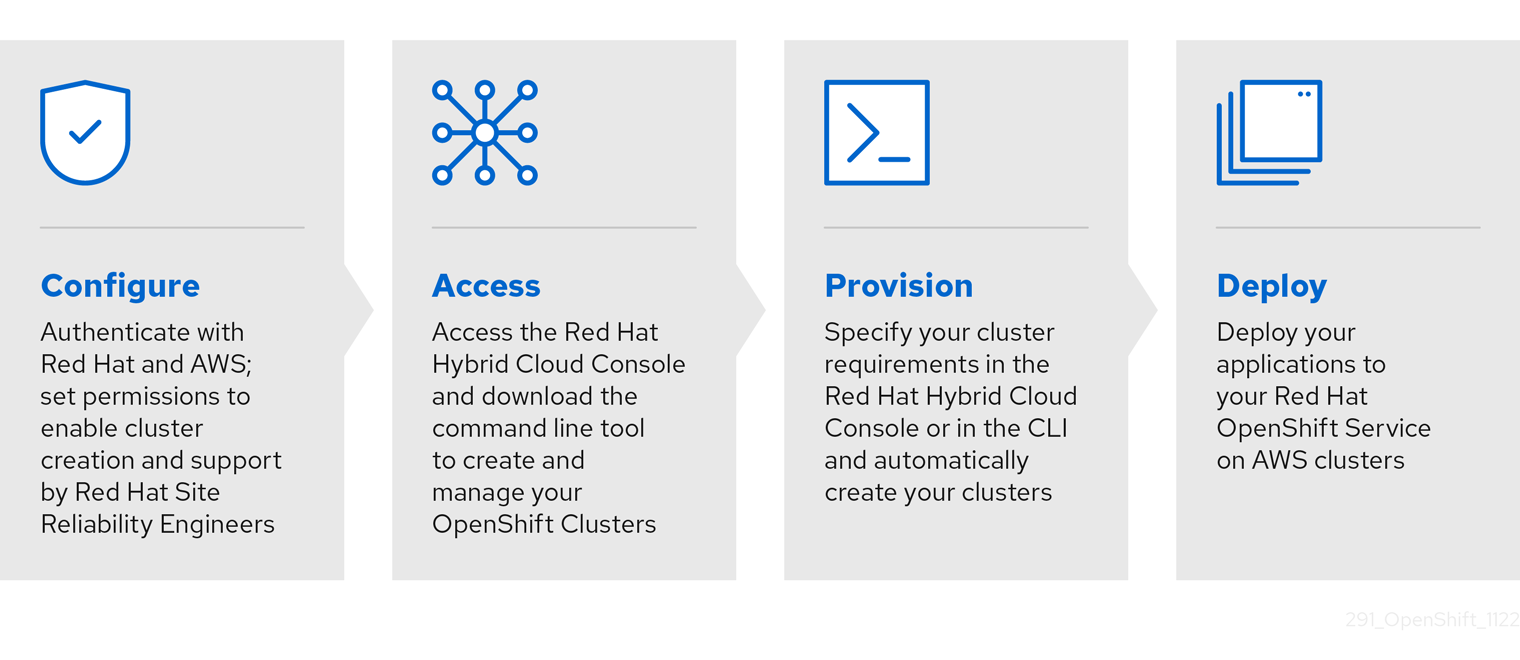Questo contenuto non è disponibile nella lingua selezionata.
Chapter 2. Red Hat OpenShift Service on AWS overview
Red Hat OpenShift Service on AWS is a fully-managed turnkey application platform that allows you to focus on what matters most, delivering value to your customers by building and deploying applications. Red Hat and AWS SRE experts manage the underlying platform so you do not have to worry about infrastructure management. Red Hat OpenShift Service on AWS provides seamless integration with a wide range of AWS compute, database, analytics, machine learning, networking, mobile, AI and other services to further accelerate the building and delivering of differentiating experiences to your customers.
Red Hat OpenShift Service on AWS offers a reduced-cost solution to create a managed Red Hat OpenShift Service on AWS cluster with a focus on efficiency and security. You can quickly create a new cluster and deploy applications in minutes.
You subscribe to the service directly from your AWS account. After you create clusters, you can operate your clusters with the OpenShift web console, the rosa CLI, or through Red Hat OpenShift Cluster Manager.
You receive OpenShift updates with new feature releases and a shared, common source for alignment with OpenShift Container Platform. Red Hat OpenShift Service on AWS supports the same versions of OpenShift as Red Hat OpenShift Container Platform to achieve version consistency.
Red Hat OpenShift Service on AWS uses AWS Security Token Service (STS) with AWS IAM to obtain credentials to manage infrastructure in your AWS account. AWS STS is a global web service that creates temporary credentials for IAM users/roles or federated users/roles. Red Hat OpenShift Service on AWS uses this to assign short-term, limited-privilege, security credentials. These credentials are associated with IAM roles that are specific to each component that makes AWS API calls. This method aligns with the principals of least privilege and secure practices in cloud service resource management. The ROSA command-line interface (CLI) tool manages the STS credentials that are assigned for unique tasks and takes action on AWS resources as part of OpenShift functionality. For a more detailed explanation, see AWS STS and Red Hat OpenShift Service on AWS explained.
2.1. Key features of Red Hat OpenShift Service on AWS
- Cluster node scaling: Red Hat OpenShift Service on AWS requires a minimum of only two nodes, making it ideal for smaller projects while still being able to scale to support larger projects and enterprises. Easily add or remove compute nodes to match resource demand. Autoscaling allows you to automatically adjust the size of the cluster based on the current workload. See About autoscaling nodes on a cluster for more details.
- Fully managed underlying control plane infrastructure: Control plane components, such as the API server and etcd database, are hosted in a Red Hat-owned AWS account.
- Rapid provisioning time: Provisioning time is approximately 10 minutes.
- Continued cluster operation during upgrades: Customers can upgrade the control plane and machine pools separately, ensuring the cluster remains operational during the upgrade process.
- Native AWS service: Access and use Red Hat OpenShift on-demand with a self-service onboarding experience through the AWS management console.
- Flexible, consumption-based pricing: Scale to your business needs and pay as you go with flexible pricing and an on-demand hourly or annual billing model.
- Single bill for Red Hat OpenShift and AWS usage: Customers will receive a single bill from AWS for both Red Hat OpenShift and AWS consumption.
- Fully integrated support experience: Management, maintenance, and upgrades are performed by Red Hat site reliability engineers (SREs) with joint Red Hat and Amazon support and a 99.95% service-level agreement (SLA). See the Red Hat OpenShift Service on AWS support documentation for more details.
- AWS service integration: AWS has a robust portfolio of cloud services, such as compute, storage, networking, database, analytics, Virtualization and AI. All of these services are directly accessible through Red Hat OpenShift Service on AWS. This makes it easier to build, operate, and scale globally and on-demand through a familiar management interface.
- Maximum availability: Deploy clusters across multiple availability zones in supported regions to maximize availability and maintain high availability for your most demanding mission-critical applications and data.
- Optimized clusters: Choose from memory-optimized, compute-optimized, general purpose, or accelerated EC2 instance types with clusters to meet your needs.
- Global availability: Refer to the product regional availability page to see where Red Hat OpenShift Service on AWS is available globally.
2.2. Billing and pricing
Red Hat OpenShift Service on AWS is billed directly to your Amazon Web Services (AWS) account. ROSA pricing is consumption based, with annual commitments or three-year commitments for greater discounting. The total cost of ROSA consists of two components:
- ROSA service fees
- AWS infrastructure fees
Visit the Red Hat OpenShift Service on AWS Pricing page on the AWS website for more details.
2.3. Getting started with Red Hat OpenShift Service on AWS
Use the following sections to find content to help you learn about and use Red Hat OpenShift Service on AWS.
2.3.1. Architect
| Learn about Red Hat OpenShift Service on AWS | Plan Red Hat OpenShift Service on AWS deployment | Additional resources |
|---|---|---|
| Understanding process and security | ||
2.3.2. Cluster Administrator
| Learn about Red Hat OpenShift Service on AWS | Deploy Red Hat OpenShift Service on AWS | Manage Red Hat OpenShift Service on AWS | Additional resources |
|---|---|---|---|
| About Red Hat OpenShift Service on AWS monitoring | |||
2.3.3. Developer
| Learn about application development in Red Hat OpenShift Service on AWS | Deploy applications | Additional resources |
|---|---|---|
| Red Hat OpenShift Dev Spaces (formerly Red Hat CodeReady Workspaces) | ||
2.3.4. Before creating your first Red Hat OpenShift Service on AWS cluster
For additional information about ROSA installation, see a quick introduction to the process in Installing Red Hat OpenShift Service on AWS interactive walkthrough.
